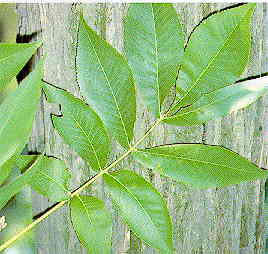Carya laciniosa - (Shellbark Hickory)

Shellbark Hickory (Carya laciniosa)
Family: Walnut (Juglandaceae)
Flowering: April-May.
Field Marks: This is the only shaggy barked hickory that usually has 7 or 9 leaflets and a fruit at least 2 inches in diameter. The axis that bears the leaflets usually persists on the tree until the following summer.
Habitat: Low woods, along streams.
Habit: Tree up to 100 feet tall, with trunk diameter up to 3 feet; crown oblong to ovoid, with drooping lower branches.
Bark: Light gray, separating into long, thick vertical plates which curve away from the trunk.
Buds: Dark brown, hairy, up to 3/4 inch long, the outer scales with a long, stiff point.
Leaves: Alternate, pinnately compound, with 5, 7, or 9 leaflets; the leaflets lanceolate to ovate, pointed at the tip, tapering or rounded at the base, finely toothed, dark green and mostly smooth on the upper surface, paler and softly hairy on the lower surface, up to 10 inches long, about 1/2 as wide.
Flowers: Male and female flowers borne separately but on the same tree, appearing after the leaves have begun to unfold, without petals, the male flowers in slender, drooping spikes; the female flowers in clusters of 2-5. Fruits: Spherical, often slightly sunken at the top, up to 1 1/4 inches in diameter, the husk divided all the way to the base into four sections, minutely orange-speckled and sometimes hairy, the nut with conspicuous ridges, the kernel very sweet.
Notes: The nuts are eaten by a variety of animals, including man. The wood of the shellbark hickory is used for tool handles and fuel.
Carya laciniosa: (Shellbark Hickory) 60-80ft; straight tree with edible nuts; yellow-golden fall color; attractive shaggy bark.
Planted four in Spring of 1998
![]()
![]()
 Wildflower
Seed For Sale
Wildflower
Seed For Sale